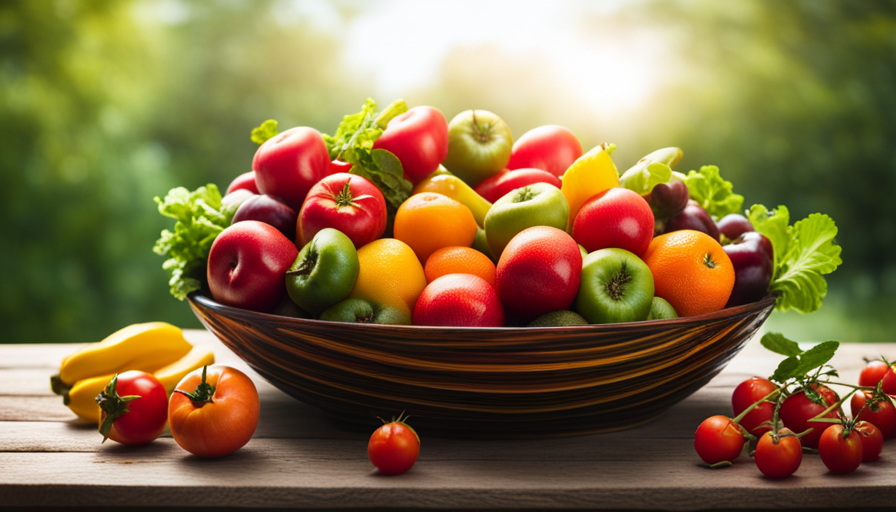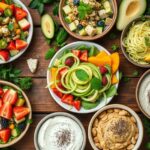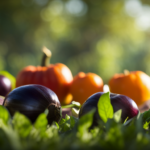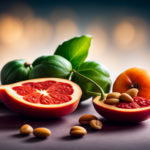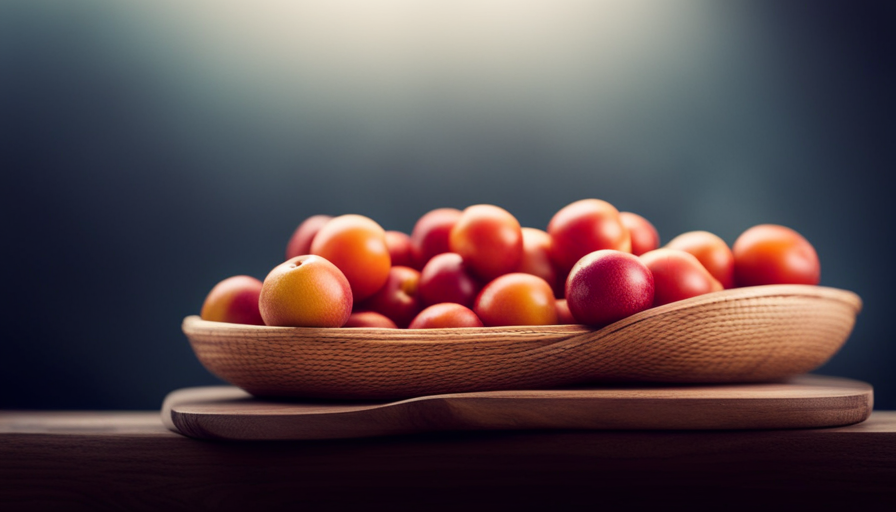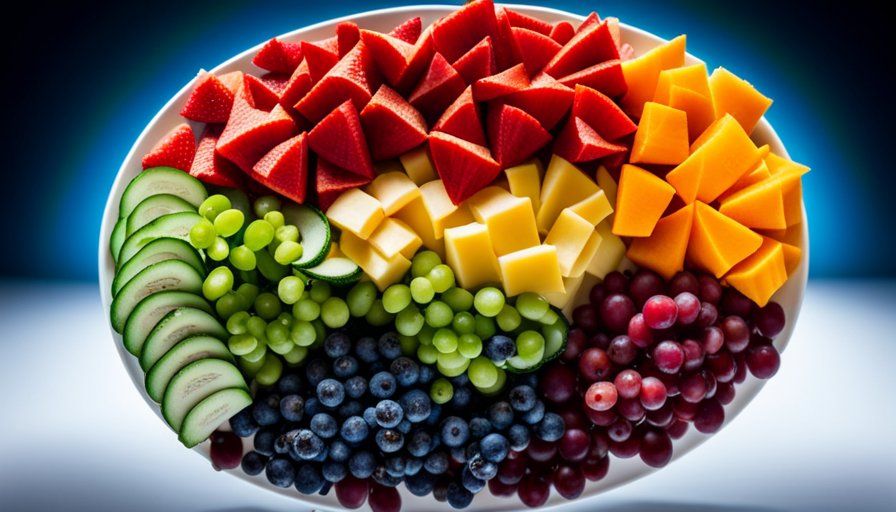Imagine a vibrant garden overflowing with life and abundance, basking in the nourishing rays of the sun. As the caretaker of this garden, you embody a lifestyle deeply rooted in nature’s purest essence. Step into the realm of the raw food vegan diet, where the power of raw fruits and vegetables is celebrated for their ability to fuel and heal the body. Welcome to a world where nature’s bounty is at the heart of your well-being.
In this article, we will guide you on a journey through the principles, benefits, and practical tips of adopting a raw food vegan lifestyle. You will discover the incredible health benefits that come from consuming a diet rich in living, nutrient-dense foods. We will delve into the art of incorporating raw fruits and vegetables into your meals, explore mouthwatering raw food recipes, and help you create a meal plan that supports your new lifestyle.
Additionally, we will share valuable advice on proper food storage and preservation, as well as navigating social situations and dining out as a raw food vegan. We will address the challenges that may arise on this journey and provide guidance on maintaining balance and listening to your body’s needs.
So, if you are ready to embark on a transformative path towards optimal health and vitality, let’s dive into the world of the raw food vegan diet together. Get ready to awaken your senses and nourish your body from the inside out.
Key Takeaways
- Transitioning to a raw food vegan diet requires planning and gradual incorporation of more raw foods while reducing cooked and processed foods.
- Incorporating raw fruits and vegetables can be done through salads, smoothies, toppings, and more, and can support weight loss due to their low calorie and high fiber content.
- Meal planning and a balanced diet are important for a raw food vegan lifestyle as they ensure a satisfying and nourishing eating experience, and raw foods are rich in vitamins, minerals, and antioxidants that boost the immune system.
- Navigating social situations and dining out on a raw food vegan diet requires communication, research, preparation, and social etiquette. It’s important to research restaurants that offer raw food or vegan options, carry raw food snacks, and be respectful of others’ food choices.
Understanding the Raw Food Vegan Diet
Imagine yourself sitting down to a vibrant and colorful plate of fresh fruits, vegetables, and leafy greens, as you embark on the journey of understanding the raw food vegan diet. The raw food vegan diet is a plant-based lifestyle that focuses on consuming uncooked and unprocessed foods. By eating foods in their raw state, you’re able to maximize their nutritional content and enzymes, which can positively impact your health.
Understanding the benefits of a raw food vegan diet is essential in making a successful transition. Raw foods are rich in vitamins, minerals, and antioxidants, which can boost your immune system and support overall well-being. Additionally, the enzymes present in raw foods aid in digestion and can improve nutrient absorption. Many raw food enthusiasts report increased energy levels, improved digestion, and weight loss as they adopt this lifestyle.
Transitioning to a raw food vegan diet requires planning and preparation. Start by gradually incorporating more raw foods into your meals and reducing the amount of cooked and processed foods. Stock up on a variety of fresh fruits, vegetables, nuts, and seeds to ensure a balanced diet. It’s important to listen to your body and make adjustments as needed. Consulting with a healthcare professional or a registered dietitian can provide guidance and ensure you’re meeting your nutritional needs.
Understanding the raw food vegan diet is the first step towards adopting this lifestyle. By incorporating more raw foods into your meals and seeking professional guidance, you can enjoy the numerous health benefits that come with this plant-based approach.
Benefits of a Raw Food Vegan Diet
Reaping the rewards of a plant-based lifestyle includes enhanced vitality and a vibrant complexion. When it comes to the raw food vegan diet, the benefits are plentiful. Not only does this diet promote overall health and well-being, but it can also aid in weight loss.
Here are some key health benefits of following a raw food vegan diet:
-
Increased nutrient intake: By consuming raw fruits, vegetables, nuts, and seeds, you’re providing your body with a rich source of essential vitamins, minerals, and antioxidants. These nutrients are crucial for maintaining optimal health and preventing chronic diseases.
-
Improved digestion: Raw foods are packed with natural enzymes that aid in digestion. These enzymes help break down the food you consume, making it easier for your body to absorb and utilize the nutrients.
-
Enhanced weight loss: The raw food vegan diet is naturally low in calories and high in fiber, making it an excellent choice for those looking to shed some pounds. The high fiber content helps you feel fuller for longer, reducing the likelihood of overeating.
-
Reduced risk of chronic diseases: Studies have shown that a raw food vegan diet can help lower the risk of heart disease, diabetes, and certain types of cancer. This is due to the abundance of antioxidants and phytochemicals found in raw plant-based foods.
Adopting a raw food vegan diet can provide numerous health benefits, including weight loss and a decreased risk of chronic diseases. So why not give it a try and experience the positive changes for yourself?
Incorporating Raw Fruits and Vegetables into Your Meals
Try adding a burst of color to your meals by incorporating vibrant, fresh fruits and vegetables that will awaken your taste buds and bring a burst of energy to your plate. Not only are raw fruits and vegetables delicious, but they are also packed with essential nutrients that can support your overall health and well-being.
When it comes to incorporating raw fruits and vegetables into your meals, the possibilities are endless. You can enjoy them as a refreshing salad, blend them into a smoothie, or use them as a topping for your favorite dishes. The key is to experiment and find what works best for you.
To give you some inspiration, here’s an example of a 2 column and 4 row table showcasing different ways to incorporate raw fruits and vegetables into your meals:
| Breakfast | Lunch | Dinner | Snacks |
|---|---|---|---|
| Green smoothie | Raw veggie wrap | Zucchini pasta | Apple slices |
| Chia pudding | Veggie salad | Raw sushi | Carrot sticks |
| Fresh fruit bowl | Nori rolls | Cauliflower rice | Celery sticks |
| Avocado toast | Raw veggie soup | Raw tacos | Cucumber slices |
In addition to adding flavor and variety to your meals, incorporating raw fruits and vegetables into your diet can also support weight loss. These foods are low in calories and high in fiber, which can help you feel full and satisfied while still providing the nutrients your body needs.
Even if you have a busy lifestyle, it’s still possible to incorporate raw food into your diet. You can meal prep by washing and cutting up fruits and vegetables in advance, or choose quick and easy recipes that require minimal preparation. By making small changes and being creative with your meals, you can easily incorporate raw fruits and vegetables into your busy schedule. Remember, a raw food vegan diet can be both delicious and nutritious!
Exploring Nutritious Raw Food Recipes
Discover the endless possibilities of nutritious raw food recipes that’ll leave your taste buds tingling with excitement and your body nourished and energized.
Exploring flavor combinations is key when it comes to creating delicious raw food meals. With the abundance of fresh fruits and vegetables available, you can mix and match various flavors to create a vibrant and satisfying dish.
One exciting flavor combination to try is the classic pairing of mango and avocado. Slicing ripe mangoes and creamy avocados into bite-sized pieces and tossing them together creates a refreshing and sweet salad. The natural sweetness of the mango complements the rich and creamy texture of the avocado, making it a perfect snack for those hot summer days.
Another tasty option is to create a raw food vegan salsa using tomatoes, onions, cilantro, and lime juice. This vibrant salsa can be enjoyed on its own or served with raw vegetable chips for a satisfying crunch. The combination of tangy tomatoes, aromatic onions, and zesty lime juice creates a burst of flavors that’ll leave you wanting more.
For a quick and easy raw food vegan snack, try making zucchini noodles with a creamy cashew sauce. Spiralizing fresh zucchinis into noodle-like shapes and tossing them with a creamy cashew sauce creates a dish reminiscent of traditional pasta. The cashew sauce adds a rich and savory flavor that pairs perfectly with the freshness of the zucchini.
Exploring nutritious raw food recipes allows you to enjoy the benefits of a raw food vegan diet while indulging in delicious flavors. Incorporate these flavor combinations and snack ideas into your meals to create a satisfying and nourishing eating experience.
Meal Planning for a Raw Food Vegan Lifestyle
To make the most of your raw food vegan lifestyle, plan your meals in advance to ensure a variety of nutritious and satisfying options. Meal prepping and grocery shopping are key components of successful meal planning. By dedicating a specific time each week to plan and prepare your meals, you can save time and make healthier choices throughout the week.
When meal prepping for a raw food vegan diet, it’s important to focus on incorporating a wide range of fruits, vegetables, nuts, and seeds into your meals. These foods are packed with essential vitamins, minerals, and antioxidants that can support your overall health and well-being.
To help you get started with meal planning, here’s a simple table that you can use to organize your meals for the week:
| Day | Breakfast | Lunch | Dinner |
|---|---|---|---|
| Monday | Green Smoothie | Raw Salad | Zucchini Noodles |
| Tuesday | Chia Pudding | Veggie Wrap | Raw Soup |
| Wednesday | Fruit Bowl | Raw Veggie Sushi | Raw Pad Thai |
| Thursday | Overnight Oats | Raw Nori Rolls | Raw Lasagna |
By planning your meals ahead of time, you can ensure that you have all the necessary ingredients on hand and make healthier choices. This can help you stay on track with your raw food vegan lifestyle and make it easier to maintain a balanced and nutritious diet.
Essential Kitchen Tools for a Raw Food Vegan Diet
Equipped with the right kitchen tools, your culinary journey in the world of vibrant, plant-based creations will be a breeze. Kitchen organization is key when it comes to preparing raw food vegan meals. Having a well-organized kitchen will not only save you time, but it’ll also make the food preparation process much more enjoyable.
Here are some essential kitchen tools that will help you stay organized and make your raw food vegan diet a success:
-
High-speed blender: A must-have for any raw food vegan, it allows you to easily make creamy smoothies, nut milks, and sauces.
-
Food processor: Perfect for chopping, shredding, and slicing vegetables and fruits, it’s a versatile tool that’ll make meal prep a breeze.
-
Spiralizer: Essential for creating delicious and healthy raw pasta dishes, you can use it to make zucchini noodles or sweet potato noodles.
-
Dehydrator: A game-changer for raw food vegans, it allows you to create crispy snacks like kale chips and fruit leather without using any oil.
-
Mandoline slicer: Perfect for achieving uniform slices of vegetables and fruits, it’s great for making raw lasagna or vegetable chips.
By having these essential kitchen tools, you’ll be able to stay organized and effortlessly prepare delicious raw food vegan meals. Happy cooking!
Tips for Proper Food Storage and Preservation
Having a well-organized kitchen and proper food storage is like having a well-stocked toolkit for a chef, ensuring that ingredients stay fresh and flavors are preserved. When it comes to a raw food vegan diet, it is important to properly store and preserve your food to maintain its nutritional value. Here are some food preservation techniques and the best storage containers to use:
Food Preservation Techniques:
-
Dehydrating: This method involves removing moisture from food to extend its shelf life. Invest in a good food dehydrator to dry fruits, vegetables, and nuts.
-
Freezing: Freezing is an effective way to preserve the freshness of raw food. Use airtight containers or freezer bags to prevent freezer burn.
-
Fermenting: Fermentation not only preserves food but also increases its nutritional value. Fermented foods like sauerkraut and kimchi can be stored in glass jars with airtight lids.
-
Vacuum sealing: Vacuum sealing removes air from the storage container, preventing the growth of bacteria and mold. It is ideal for storing prepared raw meals.
Best Storage Containers:
-
Glass containers: Glass containers are non-toxic and do not leach chemicals into your food. They are also reusable and easy to clean.
-
Mason jars: These versatile jars are perfect for storing fermented foods, dressings, and sauces.
-
Silicone bags: Silicone bags are a great alternative to plastic bags. They are reusable, easy to clean, and can be used for both storing and freezing food.
-
Stainless steel containers: Stainless steel containers are durable, lightweight, and eco-friendly. They are ideal for packing lunches or storing prepared meals.
By following these food preservation techniques and using the best storage containers, you can ensure that your raw food vegan diet remains fresh, flavorful, and packed with nutrients.
Navigating Social Situations and Dining Out as a Raw Food Vegan
When socializing or dining out, raw food vegans may face challenges in finding suitable options that align with their dietary preferences. However, with a little planning and preparation, navigating these social situations can become easier.
Here are some tips to help you maintain your raw food vegan lifestyle while socializing or dining out:
-
Communicate your dietary needs: Let your friends, family, or restaurant staff know about your dietary preferences in advance. This’ll allow them to make necessary accommodations and ensure there are suitable options available for you.
-
Research restaurants in advance: Before dining out, research restaurants in your area that offer raw food or vegan options. Many restaurants now cater to various dietary needs, so finding a suitable option shouldn’t be too difficult.
-
Be prepared: In case there aren’t any suitable options available, carry some raw food snacks with you. Nuts, seeds, and fresh fruits can be great portable options to keep you satiated.
-
Learn social etiquette: When dining out, it’s important to be respectful and understanding of others’ choices. Avoid criticizing or judging others for their food choices, as this can create tension and discomfort.
-
Deal with criticism gracefully: Unfortunately, raw food vegans often face criticism or skepticism from others. Instead of getting defensive, educate others about the benefits of a raw food vegan diet and share your personal experiences.
By following these tips, you can confidently navigate social situations and dining out as a raw food vegan while maintaining social etiquette and dealing with criticism in a graceful manner.
Overcoming Challenges and Maintaining Balance on a Raw Food Vegan Diet
Don’t worry, you’ll never have to struggle with finding creative ways to incorporate variety and balance into your plant-based meals. Overcoming challenges and maintaining balance on a raw food vegan diet can be easier than you think.
One challenge many people face is the lack of variety in their meals. However, with a little planning and creativity, you can ensure that your meals are both nutritious and delicious.
One way to overcome this challenge is by experimenting with different fruits, vegetables, and spices. Try incorporating a wide range of colors and flavors into your meals to keep things interesting. Additionally, don’t be afraid to try new recipes or adapt traditional dishes to fit your raw food vegan diet.
Another challenge you may encounter is maintaining a balanced intake of nutrients. Raw food vegan diets can sometimes lack certain essential nutrients, such as vitamin B12 and omega-3 fatty acids. To ensure you’re getting all the necessary nutrients, consider taking supplements or incorporating fortified foods into your diet.
It’s important to listen to your body and make adjustments as needed. If you’re feeling low on energy or experiencing any negative symptoms, it may be a sign that you need to make some changes to your diet. Don’t be too hard on yourself and remember that finding balance is a journey. With time and practice, you’ll become more skilled at overcoming challenges and maintaining a healthy, balanced raw food vegan diet.
Listening to Your Body and Adjusting Your Raw Food Vegan Journey
Now that you have learned about overcoming challenges and maintaining balance on a raw food vegan diet, it’s time to focus on another important aspect of this lifestyle: listening to your body and adjusting your raw food vegan journey. Adjusting cravings and finding support are crucial in ensuring that you stay on track and achieve optimal health.
When following a raw food vegan diet, it’s essential to pay attention to your body’s signals and adjust accordingly. Cravings can indicate nutrient deficiencies or imbalances, so it’s important to address them. For example, if you find yourself constantly craving sweet foods, it may be a sign that you need more natural sugars from fruits. On the other hand, craving salty foods could indicate a need for more minerals, such as seaweed or celery.
In addition to adjusting cravings, finding support is vital for long-term success on a raw food vegan journey. Surrounding yourself with like-minded individuals can provide encouragement, inspiration, and valuable tips and tricks. Joining online communities, attending local meetups, or finding a raw food vegan mentor can be excellent sources of support.
To help you visualize the importance of listening to your body and finding support, consider the following table:
| Adjusting Cravings | Finding Support |
|---|---|
| Address nutrient deficiencies or imbalances | Surround yourself with like-minded individuals |
| Pay attention to your body’s signals | Join online communities and local meetups |
| Incorporate foods that fulfill specific cravings | Seek guidance from a raw food vegan mentor |
| Experiment with alternative ingredients or recipes | Share experiences and learn from others |
By adjusting your cravings and finding support, you can navigate your raw food vegan journey with confidence and achieve optimal health. Remember, it’s a personal journey, and listening to your body is key.
Frequently Asked Questions
How can I get enough protein on a raw food vegan diet?
To ensure you get enough protein on a raw food vegan diet, focus on incorporating plant-based protein sources into your meals. Legumes, such as lentils and chickpeas, are excellent options. Nuts and seeds like almonds and chia seeds are also rich in protein. Balancing macronutrients is important, so aim to include a variety of fruits, vegetables, whole grains, and healthy fats in your diet as well.
This will help you meet your protein needs and maintain a well-rounded, nutritious eating plan.
Can I still eat cooked food occasionally on a raw food vegan diet?
Yes, you can still enjoy cooked food occasionally on a raw food vegan diet. While the main focus is on consuming raw plant-based foods, incorporating cooked food can provide variety and other benefits. Cooking methods like steaming, baking, or boiling can help enhance flavors and make certain foods easier to digest. Additionally, cooking certain vegetables can actually increase the availability of certain nutrients, such as lycopene in tomatoes. Just remember to keep the majority of your diet raw for optimal health benefits.
Are there any specific supplements I should take on a raw food vegan diet?
To ensure you’re meeting your nutrient needs on a raw food vegan diet, supplements can be helpful. Some key supplements to consider include vitamin B12, omega-3 fatty acids, iron, and vitamin D. These can help prevent potential deficiencies that may arise from a strictly raw food vegan diet.
It’s important to consult with a healthcare professional or registered dietitian to determine the right supplements for you, as individual needs may vary.
How can I prevent nutrient deficiencies on a raw food vegan diet?
To prevent nutrient deficiencies on a raw food vegan diet, there are a few key tips to keep in mind. First, focus on eating a variety of fruits, vegetables, nuts, and seeds to ensure you’re getting a wide range of nutrients.
Secondly, consider incorporating plant-based protein sources like legumes and quinoa to meet your protein needs.
Lastly, be mindful of certain nutrients like vitamin B12, iron, and omega-3 fatty acids that may require supplementation on a raw food vegan diet.
What are some common challenges people face when transitioning to a raw food vegan diet and how can I overcome them?
Overcoming cravings and finding variety in raw food meals can be common challenges when transitioning to a raw food vegan diet. To overcome cravings, focus on incorporating a wide range of fruits, vegetables, nuts, and seeds into your meals to ensure you’re getting a variety of flavors and nutrients.
Experiment with different preparation methods like marinating, fermenting, or dehydrating to add diversity to your meals. Additionally, try exploring new recipes and cuisines to keep your meals exciting and satisfying.
>Can Following These Tips Help with Eating a Raw Food Vegan Diet?
Looking for raw vegan food digestion tips to improve your raw food vegan diet? Start by incorporating fermented foods, staying hydrated, and eating smaller, more frequent meals. These simple adjustments can help support better digestion and overall gut health while following a raw food vegan diet.
Conclusion
In conclusion, adopting a raw food vegan diet can be a transformative experience for both your health and the environment. By incorporating raw fruits and vegetables into your meals, you’re providing your body with a rich source of nutrients and enzymes.
With proper meal planning and storage techniques, you can ensure that your raw food journey is sustainable and enjoyable. Remember, as the saying goes, "You’re what you eat." So why not choose to nourish your body with vibrant, living foods and embark on a new, refreshing journey towards optimal health and vitality.

